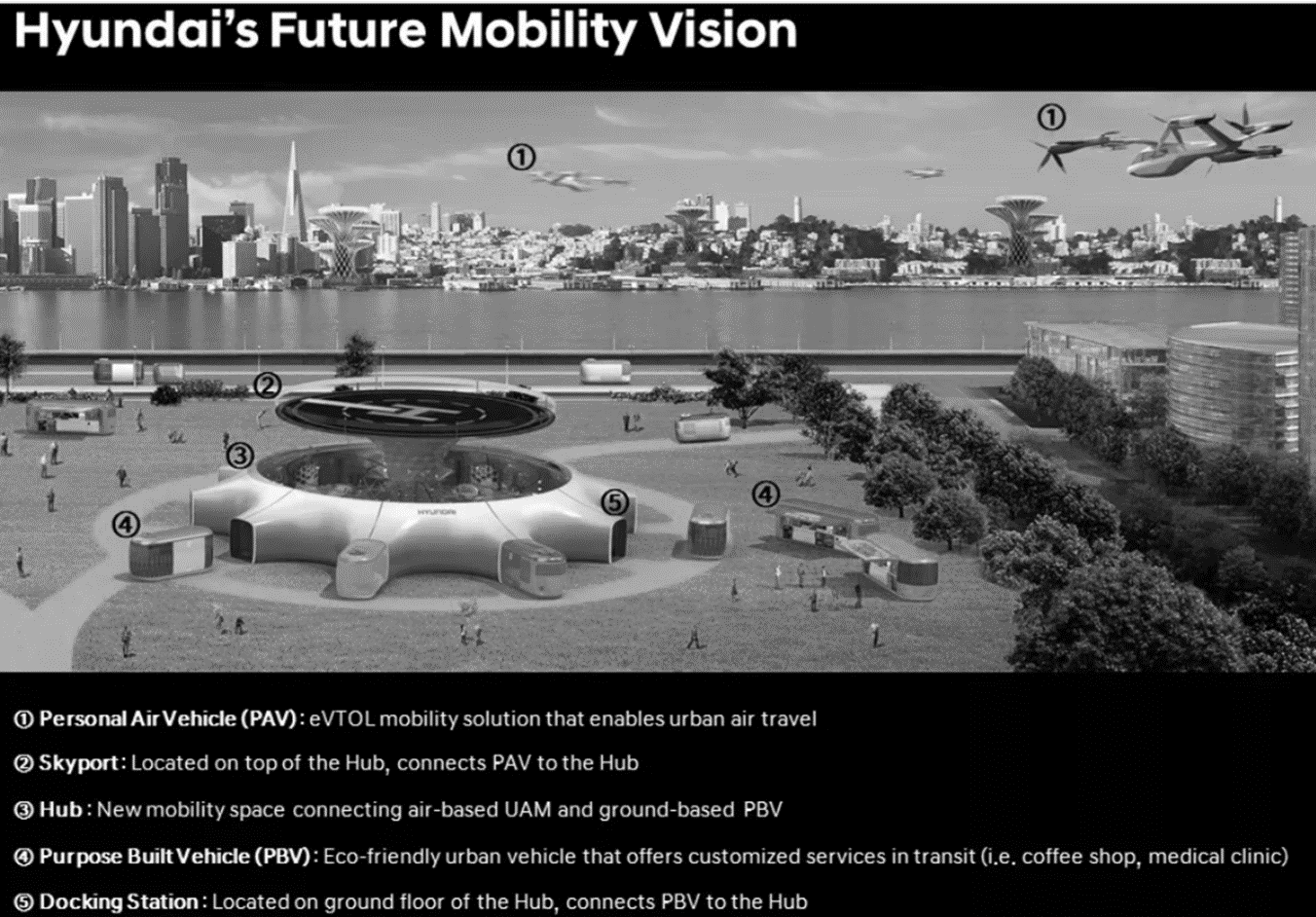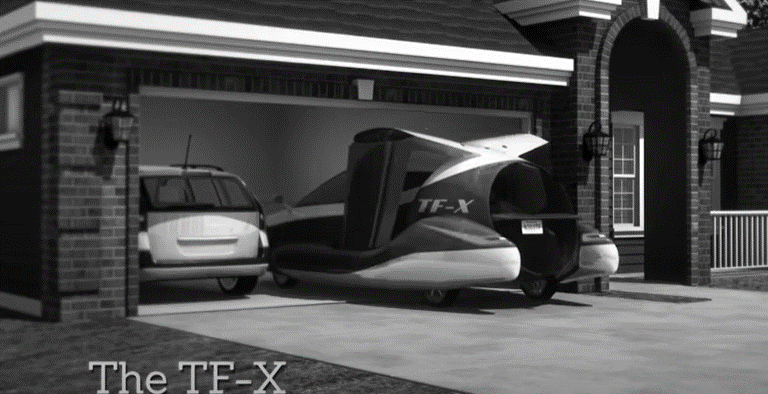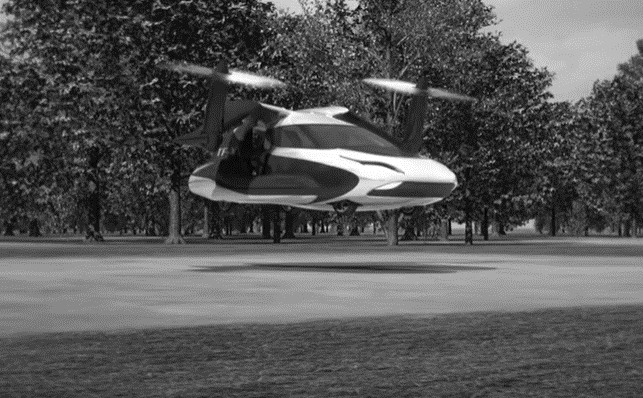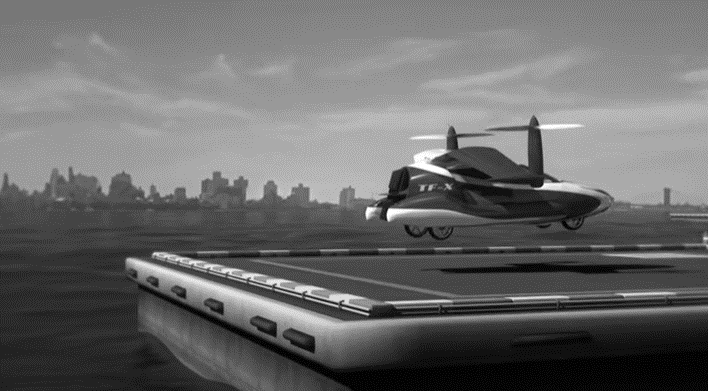INTRODUCTION
The use of Smart Mobility Solutions in Smart Cities is not only a development but a revolution itself. These days, it seems like everyone is building their own electric vertical take-off and landing (VTOL) flying car. The autonomous flying car detects and evaluates the environment, uses digital technologies to control, navigate itself without collision, travels in space, is able to take off and land and uses electric propulsion. A flying electric car in the smart city is a type of personal air vehicle that provides door-to-door transportation by both ground and air. We observe the movement, kinematic and dynamic of flying robot cars in two coordinate systems, one is tied to the ground and the other to the flying car.
Today, several companies are involved in the development of flying cars: • AeroMobil, • Volocopter, • Lilium, • Hyundai, • Uber, • Bosch, • Terrafugia. AeroMobil[1] is a Slovakian technology start-up, it has presented a concept for the eVTOL upgrade AeroMobil 5,0, which is being developed for air taxi operations. The AeroMobil 5,0 is a concept four seat flying car designed for door-to-door flying. Volocopter[2] is the electric air taxi pioneer leading the way in building up the ecosystem for urban air mobility. The VoloCity is the air taxi for the smart city. The VoloCity will become the first commercially licensed Volocopter, developed according to the high standards and requirements of the European Aviation Safety Agency (EASA). The intensive testing programme has shaped the innovative design and outstanding overall performance of the VoloCity. Quiet, safe, and comfortable, the VoloCity engenders Urban Air Mobility. Lilium[3] is developing a revolutionary on-demand air taxi service that is powered by the all-electric, vertical take-off and landing Lilium Jet. Lilium, a Munich-based startup building their own urban air mobility electric vehicles. Lilium will look to use its jet in an air taxi service ferrying people around cities. Hyundai and Uber are also developing air taxis[4], shown in Figure 2. Hyundai’s aerial taxi would be able to take off and land vertically, accommodate four passengers and cruise at up to 322 km/h, fully electric with a range of 96 km. Hyundai and Uber team up to debuted new flying taxis at CES 2020.
Bosch is developing a universal control unit and sensors for self-driving air taxis. In this article, we review the latest developments in flying cars (Terra Fugia TF-X). Many prototypes have been built in the last years using a variety of flight technologies and some have true VTOL performance[5][6][7][8][9][10][11][12][13][14][15][16][17][18].
TERRAFUGIA TF-X FLYING CAR
Terrafugia is a leader of the mobility revolution. They are executing a multi-step strategy to make air transportation a part of everyday travel. Terrafugia have a flying road electric vehicle. Terrafugia announced the TF-X, a plug-in hybrid tilt-rotor vehicle that would be the first fully autonomous flying car. Terrafugia is a Chinese-owned company headquartered in Woburn, Massachusetts, USA[19]. In our opinion, today the Terrafugia TF-X flying car is the best solution, as it is a fully autonomous flying car[20]. The TF-X is designed to be able to lower their rotors, allowing the vehicle to also operate as a road vehicle. The main data of the Terrafugia TF-X flying car are as follows: maximum speed: 322 km/h, 805 km range, vertical take-off and landing (VTOL), four seats. The following figures, Figure 3-6, show the road traffic of the Terrafugia TF-X flying car as a wheeled road vehicle and in flight.
The US Federal Aviation Administration (FAA) has granted Terrafugia special permission to carry out in-air tests of its TF-X flying car. The American flying car company Terrafugia has been a clear leader in the development of flying cars. Recently, Terrafugia unveiled its newly designed TF-X flying car with much sleeker body and VTOL system. it is the nearest we have gotten to a realistic flying car. Now, thanks to FAA’s permission. Terrafugia is allowed to start testing the prototype of its flying car.
CONCLUSIONS
The present article has reviewed the latest developments in flying cars. The autonomous flying car detects and evaluates the environment, uses digital technologies to control, navigate itself without collision, travels in space, is able to take off and land (VTOL) and uses electric propulsion. Today, several companies are developing flying cars: Terrafugia, Aero Mobil, Volocopter, Lilium, Hyundai, Uber, Bosch. Many prototypes have been built in the last years using a variety of flight technologies and some have true VTOL performance. Terrafugia is a leader of the mobility revolution. The Terrafugia TF-X flying car is the best solution, as it is a fully autonomous flying car. The TF-X is designed to be able to lower their rotors, allowing the vehicle to also operate as a road vehicle






